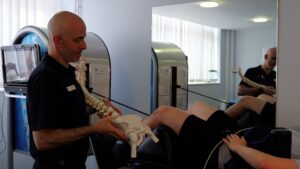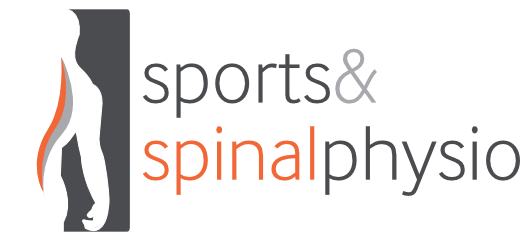News & Blog
Unresolved Back Pain, Neck Pain and Nerve Pain – How does IDD Therapy Spinal Decompression Help

What is IDD Therapy?
At our clinic, we frequently encounter individuals who are struggling with back pain and neck pain that have yet to be resolved. Many ask us about our IDD Therapy spinal decompression (IDD) service.
To gain a better understanding of IDD, it’s important to first consider the context of unresolved back pain. Typically, the body has a natural healing mechanism that resolves most back pain. However, there are times when this mechanism does not work or takes too long to work.
In such cases, manual therapy and exercise are often used to provide relief. Clinicians can use a variety of techniques, such as relieving muscle spasm or manually mobilising a joint to help it move freely, to assist the body in the healing process.
(jump to the bottom of this page if you want to watch our video instead)
Spine Health
The spine is a complex part of our body that can develop various conditions over time. Just like our leg muscles can lose strength and flexibility, our spine can experience the same.
Keeping our spine healthy requires movement. When we sustain an injury, such as a bulging or herniated disc, or experience progressive degeneration that puts pressure on joints or nerves. The body may not be able to move effectively enough for natural healing mechanisms to operate.
When spinal segments become stiff and immobile, it can have a negative impact on the sponge-like discs in our spine. These intervertebral discs act as shock absorbers between the vertebrae in our spine.
Intervertebral discs rely on a process of osmosis to receive nutrients and fluid for replenishment, and movement plays a crucial role in this. This is why mobility is essential for maintaining the health of our intervertebral discs.
Manual Therapy and IDD Therapy
Improving mobility and increasing strength through manual therapy and exercise can be effective for many conditions. However, in some cases, additional assistance may be necessary.
That’s where IDD comes in. The Accu-SPINA machine is a computer-controlled device that enables targeted spinal segment decompression and gentle improvement of spinal mobility.
This treatment tool supports the body, reduces pain, and gradually restores function.
About IDD Therapy
In simple terms, IDD Therapy involves decompressing a specific spinal segment by gently manipulating the muscles and ligaments surrounding it. This helps to restore function and activate the body’s natural healing mechanisms.
Using controlled stretching techniques, IDD Therapy opens up the space between two vertebrae, alleviating pressure on the disc and creating a negative pressure that may help retract a bulging disc. At the same time, the therapy works to free up movement in the joint’s tissues.
As the joint is opened up, a series of oscillations or mobilisations are performed to further work the tissues and create small pressure differentials. This helps to improve the tissues and range of motion, as well as stimulate fluid exchange across the joint surfaces. All of these effects work together to progressively improve mobility, restore function, and reduce pain.
How does IDD Therapy achieve this?
To connect patients to the SPINA machine, two harnesses are used. One harness is fastened around the pelvis and connected to a motor on the machine tower, while the other harness secures the patient’s chest to the top of the table.
The motor utilises a strap, similar to a car seat belt, to connect to the pelvis harness. It is then raised to a specific level to create a measured angle to the patient’s body. Once this is achieved, the computer program is set and the motor gently pulls on the pelvic harness.
The harness works like a pair of hands on the pelvis, providing a secure hold. There are several important factors to consider when administering the pulling force, which can make a significant difference.
Angle
Spinal issues, such as bulging or herniated discs, are usually found at a particular level in the spine. In the lower back (lumbar spine), the L5S1 and L4L5 discs are common areas where problems occur, accounting for 80-90% of disc problems. However, it’s possible to treat other levels as well. In the neck (cervical spine), the C5C6 level is a common location for problems.
To focus the pulling force (distraction force) on the affected level, the angle at which the force is applied or the angle of pull can be adjusted. While older methods like traction apply general pulling forces to the spine, they aren’t focused on a specific level. This is one of the key differences between IDD Therapy and traditional traction, as traction isn’t specific and therefore yields poor results. This partly explains why traction is no longer used.
Force
The force used refers to the amount of pull. The spine is incredibly strong, and it is supported by the muscles, tendons, and ligaments that carry our entire body weight, allowing us to move, walk and run upright while carrying loads.
For decompressing the disc and working the tissues, an adequate force is required, which needs to be quite strong. However, the force required is actually far stronger than what can be delivered by using hands.
This strong force is sufficient to do the job required. Despite the high force (built up over time to up to and even over half bodyweight), the patient remains completely relaxed due to the way the force is administered and controlled.
Initially, a lower force is applied, similar to starting weight lifting with lighter weights. Over time and as muscles, tendons, and ligaments adapt and get stronger, the force is gradually increased over IDD Therapy sessions.
This conditioning helps to progressively improve function, which is crucial for healing. As the body adapts, small increases in force are added, which remain comfortable.
Time
This information pertains to the duration of SPINA machine usage during IDD treatment, which involves 25 minutes on the machine. The pulling forces used on the machine are performed in cycles, with a high tension or force being applied and held for one minute, followed by a release to a low tension for 30 seconds before repeating the process.
During the 25 minutes on the machine, the affected spinal segment is decompressed and the tissues are worked for approximately 13 minutes. The soft tissues are stretched for the full duration of the treatment since the tension does not go to zero.
IDD Therapy includes a unique feature known as oscillation, which involves applying a high tension and then oscillating, providing a controlled mobilisation effect.
Number of treatments
Have you ever wondered if going to the gym once or even once a week would make you fit? Unfortunately, it takes more than that to see a real change in your body. The IDD Therapy programme is designed to bring about a positive change in your spine and tissues, but it requires a bit of time and effort.
The programme lasts for six to eight weeks and includes twenty sessions, although some patients may need more. While some patients may start seeing improvements quickly, the programme is intended to provide long-term healing. It’s important to note that a few sessions won’t suffice for real change. Patients need to come in three to five times a week initially to see progress.
The treatment is tracked, and patient progress is monitored using internationally-recognised research tools. If a patient is making progress but still has some pain or impairment, additional treatments may be recommended. This is particularly true in cases where there are multiple problems.
It’s like going on a weight loss programme. A person may see improvements in strength and a loss of body fat, but they may still have more weight to lose. It doesn’t mean the programme isn’t working; it just needs more time. However, if there is no satisfactory progress, an alternative strategy may be needed.
Exercise and Manual Therapy
IDD Therapy is a rehabilitation program that uses gentle exercises to strengthen muscles and promote healing. Although some people may associate exercise with intense boot camp workouts, the exercises used in IDD Therapy are accessible to even those who are new to physical activity. These exercises are vital for maintaining spinal health and preventing recurring pain.
In addition to exercise, manual therapy can also be used to address various issues in the body. Every part of the body works together as one organism, so it’s important to consider how different factors may contribute to problems like a herniated disc. Manual therapy can be a helpful tool in addressing these factors and promoting overall healing.
Summary
IDD Therapy is the gold standard for spinal decompression treatment. It combines targeted force, duration of time under tension, and a program of treatments to address stiffness and immobility in a spinal segment. Unlike pain relief medication, IDD Therapy allows the body to heal efficiently by targeting the root cause of the pain.
While spinal injections such as epidural steroid injections with anaesthesia can provide temporary relief for inflammation or pain, they do not address stiffness and compression. IDD Therapy is a viable option for those who have tried standard treatments like manual therapy and exercise without success, or if those treatments are not enough prior to the injection.
Although spinal surgery can be an effective treatment option for some cases, it should only be considered when there is an urgent need to avoid long-term nerve damage or debilitating pain. Non-invasive treatment options like IDD Therapy should be the first choice unless surgery is necessary.
If you are experiencing unresolved pain and have not found relief from manual therapy and exercise, we can assess your situation and recommend if IDD Therapy is a suitable treatment option for you (for more information see sportsandspinalphysio.co.uk/idd-therapy or iddtherapy.co.uk
